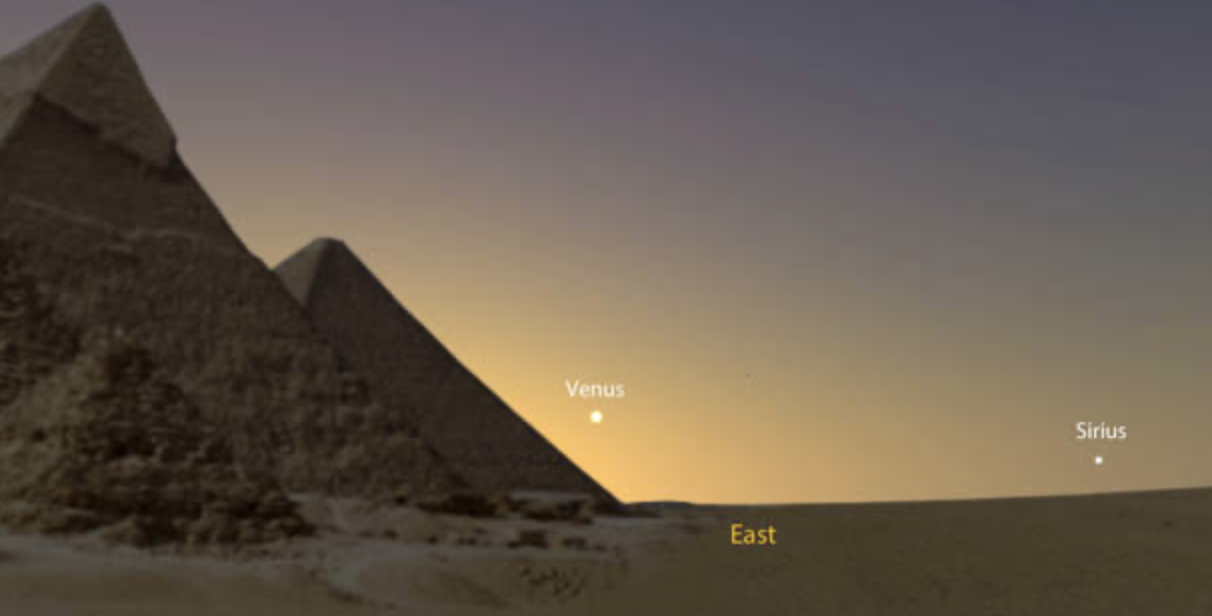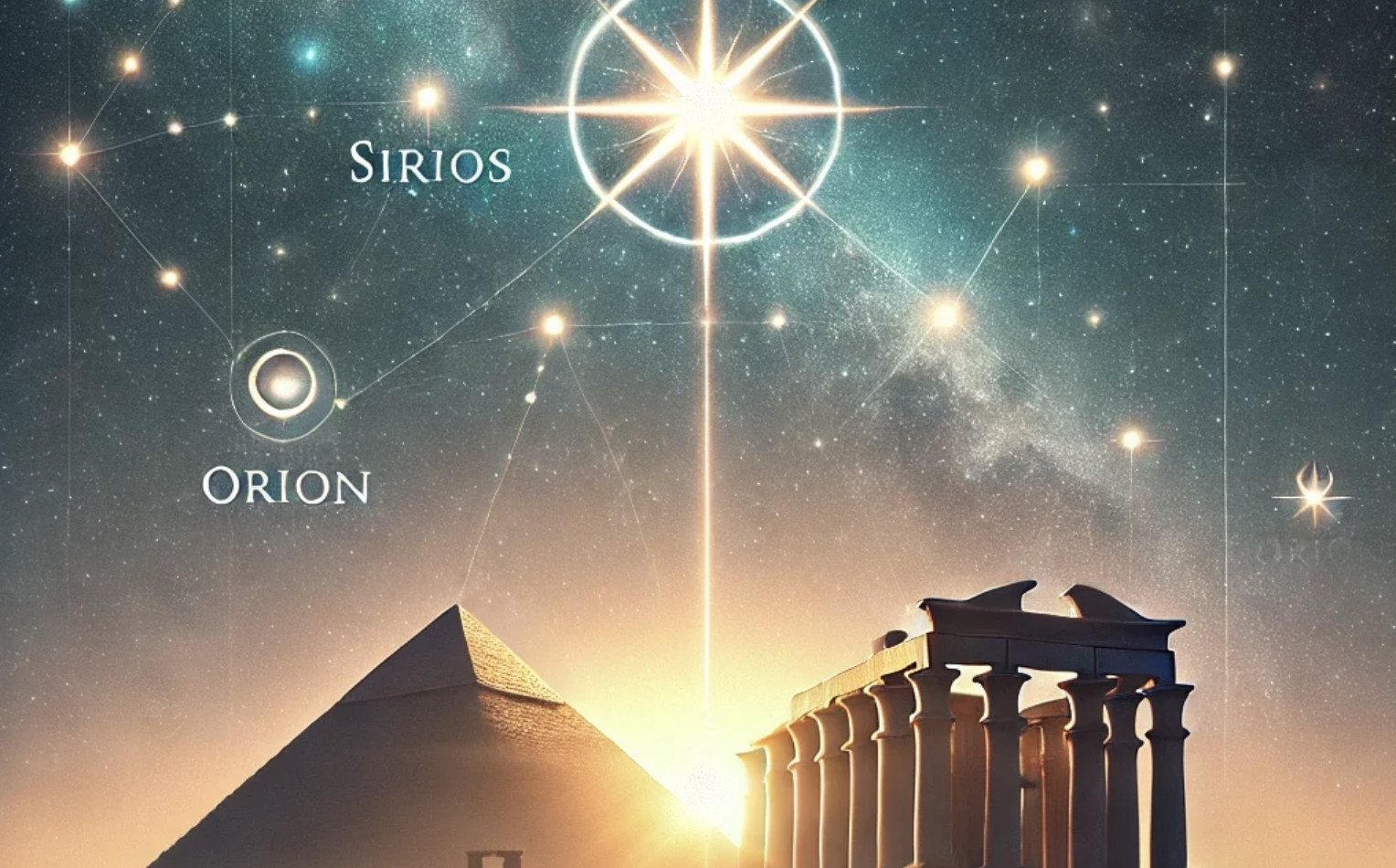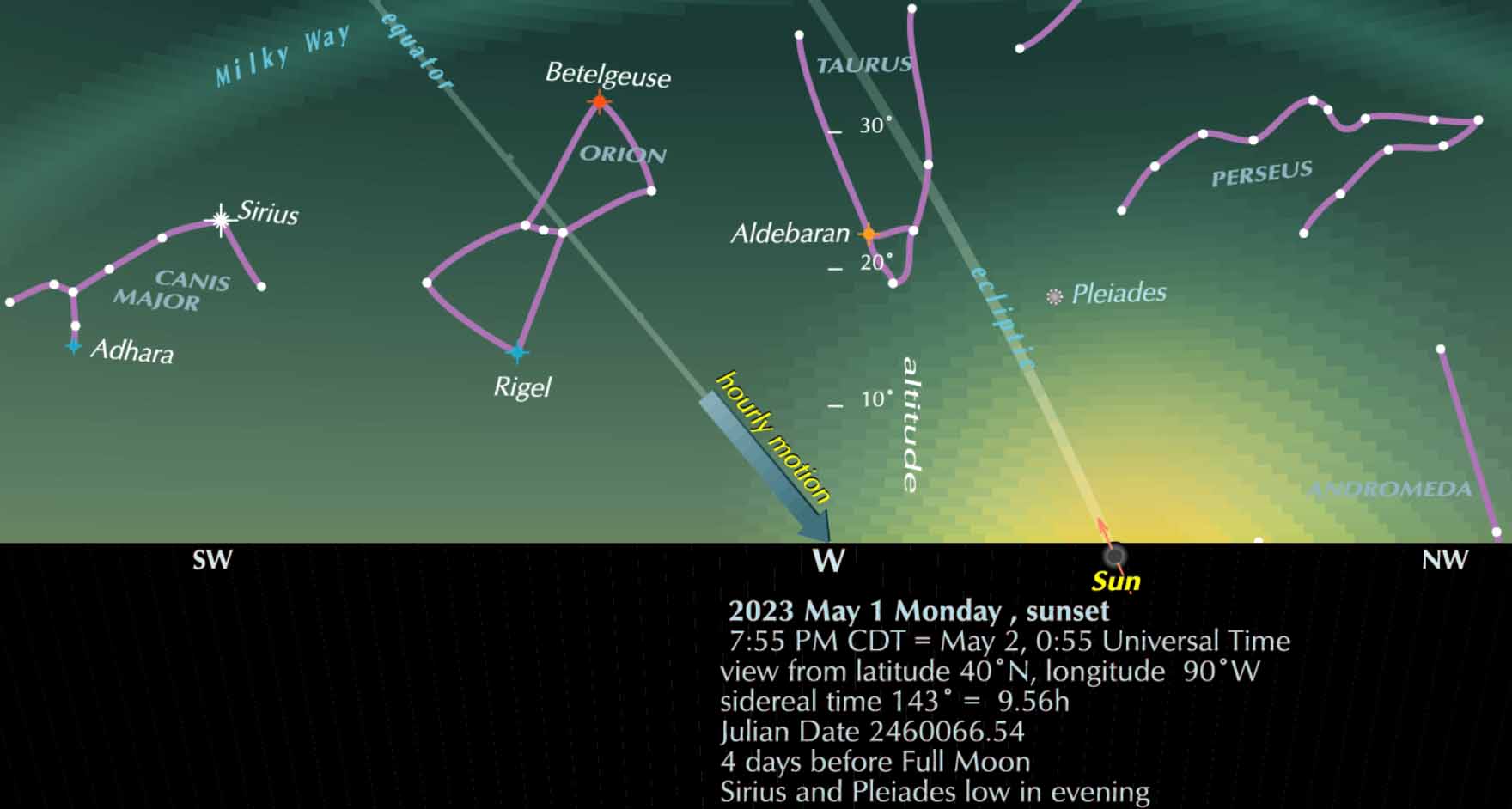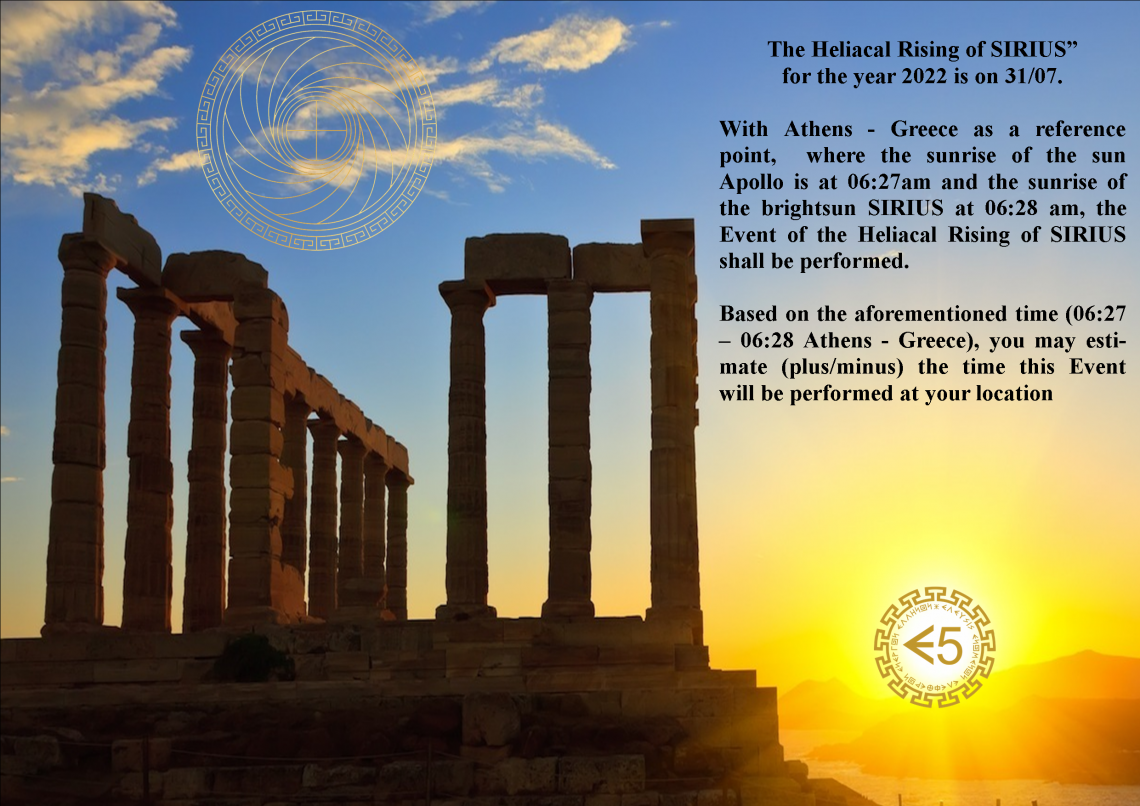|
|
The Heliacal Rising of Sirius and Visible Alignment
Created by Kemetic.appin Articles26/10/2024

The Heliacal Rising of Sirius and Visible Alignment
Throughout history, celestial events have captivated humanity, serving as markers of time, seasons, and even spiritual significance. One of the most fascinating phenomena in this realm is the heliacal rising of Sirius, the brightest star in the night sky. This event has played a crucial role in various cultures, particularly in ancient Egypt, where it signaled the onset of significant agricultural and spiritual events. In this blog, we’ll explore the heliacal rising of Sirius, its alignment with the cosmos, and its profound implications for ancient civilizations.
Understanding Heliacal Rising
Heliacal rising occurs when a star, after being obscured by the Sun's light for a period, reappears just before sunrise. For Sirius, this event typically happens in late July in the Northern Hemisphere, marking a significant seasonal shift. The star’s re-emergence heralds the end of its invisibility and has historically been associated with the start of various agricultural cycles, particularly in regions dependent on seasonal weather patterns.
Sirius: The Dog Star
Sirius, also known as the Dog Star, is part of the constellation Canis Major. It is not only the brightest star visible from Earth but also one of our closest stellar neighbors, located about 8.6 light-years away. Its brightness and prominence in the night sky have made it a focal point for various cultures throughout history.
In ancient Egypt, the heliacal rising of Sirius was especially significant. The Egyptians associated the star with the goddess Isis, who was linked to fertility, motherhood, and the annual flooding of the Nile. This flooding was crucial for agriculture, as it deposited nutrient-rich silt onto the fields, allowing crops to flourish. Thus, the heliacal rising of Sirius symbolized both the return of life and the rejuvenation of the land.
The Connection to the Nile
The alignment of the heliacal rising of Sirius with the Nile River is remarkable. The Egyptians observed that the flooding of the Nile would occur shortly after Sirius reappeared in the dawn sky. This correlation enabled them to create a calendar that marked the agricultural year and predicted the annual floods. The flooding, which typically began around mid-July, provided the fertile soil necessary for planting crops, making Sirius a cornerstone of Egyptian agriculture.
Astronomical and Spiritual Significance
The heliacal rising of Sirius was more than just an agricultural marker; it held deep spiritual significance for the Egyptians. The appearance of Sirius was thought to symbolize the resurrection of Osiris, the god of the afterlife and rebirth, who was closely linked to Isis. As such, the rising of Sirius represented a time of renewal, both in the physical world and in the spiritual realm. Festivals and rituals were often held in honor of this event, emphasizing its importance in the cultural and religious life of ancient Egyptians.
Observations and Alignments in Other Cultures
The significance of Sirius extended beyond Egypt. In various indigenous cultures around the world, this star has been associated with mythology, agriculture, and navigation. For example, the Dogon people of Mali have a rich tradition surrounding Sirius, believing in a complex astronomical relationship that includes a companion star, Sirius B. Their knowledge of this binary star system, which modern astronomy only confirmed in the 19th century, is a testament to their deep understanding of the cosmos.
Similarly, the ancient Greeks also noted the heliacal rising of Sirius, referring to it as the "Dog Star." They associated its appearance with the hot, dry days of summer, a period they called the "dog days." This connection to weather patterns further illustrates how ancient civilizations closely monitored the stars to inform their agricultural practices and daily life.
Modern Implications
In today’s context, the heliacal rising of Sirius still captures the imagination of astronomers, historians, and spiritual seekers alike. Modern astronomy allows us to calculate precisely when this event occurs, yet its historical significance continues to resonate. Many contemporary spiritual practices draw inspiration from ancient traditions, highlighting the enduring connection between humanity and the cosmos.
Moreover, the alignment of celestial bodies, including Sirius, with Earth remains an area of interest in scientific research. Understanding the patterns of stars and their impact on Earth’s environment can provide insights into climate and weather changes, linking back to the agricultural significance that Sirius once held.
Conclusion
The heliacal rising of Sirius represents a fascinating intersection of astronomy, agriculture, and spirituality. For ancient civilizations, especially the Egyptians, this event was more than a mere astronomical occurrence; it was a time of renewal, a predictor of agricultural success, and a significant marker of the seasons. As we continue to explore our relationship with the cosmos, the legacy of Sirius endures, reminding us of the profound ways in which celestial events have shaped human history and culture. Whether viewed through the lens of ancient mythology or modern science, the brilliance of Sirius continues to illuminate our understanding of the universe and our place within it.
The Heliacal Rising of Sirius and Visible Alignment | Kemetic App |
|
|
 Premier
Premier
 Précédent
2 à 7 de 7
Suivant
Précédent
2 à 7 de 7
Suivant
 Dernier
Dernier

|
|
|
The Heliacal Rising of Sirius and Visible Alignments of the Orion Constellation
Created by Kemetic.appin Articles26/10/2024
Throughout history, humans have looked to the stars for guidance, inspiration, and understanding of the universe. In ancient civilizations, celestial events were not merely random occurrences but divine phenomena deeply embedded in cultural and spiritual practices. One such significant event is the Heliacal Rising of Sirius, often celebrated in ancient Egypt for its connection to the Nile's flooding and the renewal of life. Accompanying this is the Orion Constellation, whose visible alignments further strengthened the belief in the cosmic connection between the heavens and the Earth.
The Heliacal Rising of Sirius
Sirius, also known as the "Dog Star," is the brightest star in the night sky and part of the Canis Major constellation. Its significance stems from its heliacal rising—when the star first becomes visible just before sunrise after being hidden behind the sun’s glare for a period of time. This event marks a pivotal moment in many ancient cultures, particularly in Egypt, where Sirius was associated with the goddess Isis and considered the harbinger of the annual flooding of the Nile River.
For the ancient Egyptians, the heliacal rising of Sirius typically occurred around mid-July, signaling the beginning of the new year and the vital agricultural season. The flooding of the Nile was a critical event that brought nutrient-rich soil and ensured successful harvests. As such, Sirius became synonymous with fertility, abundance, and renewal, and its rising was celebrated with grand ceremonies and rituals to honor the gods and ensure prosperity.
The Spiritual and Symbolic Significance of Sirius
Sirius was more than just a celestial body to the Egyptians; it represented a divine connection between the heavens and the Earth. The star was closely linked to the goddess Isis, the great mother and protector of the living and the dead. As the wife of Osiris and mother of Horus, Isis played a pivotal role in the Egyptian pantheon. Sirius’ rising symbolized her tears, mourning the death of Osiris, which then filled the Nile River and brought life back to the land.
This event also reinforced the Egyptians' belief in the cyclical nature of life, death, and rebirth. The flooding of the Nile, triggered by the heliacal rising of Sirius, was seen as a cosmic renewal, mirroring the rebirth of Osiris in the afterlife. For the Egyptians, the annual rising of Sirius was not only crucial for agricultural success but also for maintaining cosmic balance and harmony.
The Orion Constellation: Alignments with the Pyramids
Just as Sirius held great significance for the Egyptians, so did the Orion Constellation. Orion, a prominent figure in the night sky, was associated with Osiris, the god of the afterlife and resurrection. The three main stars of Orion’s Belt—Alnitak, Alnilam, and Mintaka—held particular importance, believed to represent the cosmic aspect of Osiris.
One of the most fascinating connections between Orion and ancient Egypt is the alignment of the Great Pyramids of Giza. It has long been suggested that the three pyramids of Giza were built to mirror the position of Orion’s Belt in the sky. This alignment is not merely architectural; it is symbolic of the Egyptians' desire to link their monumental structures with the stars and ensure that their pharaohs would ascend to the heavens after death.
The pyramids, serving as tombs for the pharaohs, were not just resting places but portals to the afterlife. The alignment with Orion’s Belt symbolized the king's journey to join Osiris in the sky, reflecting the cosmic nature of kingship and the belief in life after death. In this way, the visible alignments of the Orion Constellation reinforced the Egyptians' belief in immortality and the divine nature of their rulers.
The Celestial Connection: Sirius and Orion
The visible alignment between Sirius and Orion in the night sky formed a crucial part of the ancient Egyptian understanding of the cosmos. As two of the most prominent celestial features, they symbolized the gods Isis and Osiris, representing life, death, and rebirth. The fact that the rising of Sirius coincided with the inundation of the Nile, while Orion’s Belt aligned with the pyramids, suggested a divine plan that connected the stars, the gods, and the fate of Egypt itself.
The Egyptians believed that the soul of the deceased pharaoh would rise to the stars, particularly joining the constellation of Orion and the star Sirius. These heavenly bodies served as a guiding light for the journey to the afterlife, where the pharaoh would reign alongside Osiris and ensure the continued prosperity of Egypt.
The Legacy of Sirius and Orion
Today, the heliacal rising of Sirius and the alignment of Orion’s Belt continue to fascinate astronomers, archaeologists, and spiritual seekers alike. The precision with which the Egyptians built their monuments to align with celestial bodies is a testament to their advanced understanding of astronomy and their deep reverence for the cosmos.
For modern stargazers, the rising of Sirius is a reminder of the interconnectedness between the Earth and the stars, a connection that the ancient Egyptians held sacred. The visible alignments of Orion and the rituals surrounding the heliacal rising of Sirius show how the ancient Egyptians lived in harmony with the universe, viewing the stars as not only guides for their daily lives but also as spiritual symbols of their journey in the afterlife.
Conclusion: A Timeless Connection to the Stars
The Heliacal Rising of Sirius and the Visible Alignments of the Orion Constellation reveal the depth of the ancient Egyptians' spiritual and cosmic understanding. These celestial events were not mere phenomena to be observed—they were woven into the very fabric of Egyptian life, from their agricultural cycles to their spiritual beliefs and practices.
Today, we can look back at these celestial alignments and see the profound influence they had on one of the most remarkable civilizations in history. The next time you gaze at the night sky and spot Sirius or Orion’s Belt, you are witnessing the same cosmic dance that inspired the ancient Egyptians thousands of years ago. Their reverence for the stars and their connection to the divine continue to resonate, reminding us of the timeless bond between the heavens and the Earth.
Call to Action: Explore More on Kemetic.App
If the fascinating connection between the stars and ancient Egyptian wisdom inspires you, take the next step in your journey of discovery. Kemetic.App offers a dedicated course on The Heliacal Rising of Sirius and Visible Alignments of the Orion Constellation, where you can dive deeper into the significance of these celestial events, their spiritual meanings, and their practical impact on Egyptian culture.
By enrolling in this course, you’ll explore how these cosmic phenomena influenced ancient Egyptian life and spirituality, and how you can apply this wisdom in your own spiritual journey.
Ready to unlock the secrets of the stars? Join the course now and gain a deeper understanding of the cosmos and its divine connection to human existence.
The Heliacal Rising of Sirius and Visible Alignments of the Orion Constellation | Kemetic App |
|
|
|
|
2020, August 15-16: Heliacal Rising of Sirius
 2020, September 18: Venus, Procyon, Sirius and Orion shine from the eastern sky before sunrise.  2020, August 15-16: The heliacal rising of Sirius is the star’s first appearance in the morning sky before sunrise.
The helical rising (annual first appearance) of Sirius in the morning sky is a spectacular sight. During 2020, this occurs in mid-August.
(Reported sighting of Sirius from 33.8° north latitude with a binocular, August 6, 2020.)
(Author saw Sirius, with a binocular through a broken cloud deck, 29 minutes before sunrise on August 12, 2020. To see it without optical assistance in a few mornings, see the description below.)
(August 16: Sirius easy to see 48 minutes before sunrise without a binocular. Sky was cloudy before sunrise on August 15.)
 2020, August 14: Sirius clears the horizon 38 minutes before sunrise. The star is visible through binoculars and a short time exposure, but not with the unaided eye.  2020, August: Sirius is visible, without a binocular, in the east-southeast, 46 minutes before sunrise.
by Jeffrey L. Hunt
The spectacular appearance of a bright star in the morning before sunrise is an impressive sight. While very low in the sky, the star twinkles against the brightening hues of morning twilight.
The first morning appearance of a star in the eastern sky before sunrise is known as the “heliacal rising” of the star.
The first morning appearance of Sirius attracts attention. The brightest star in the sky, it can be found near the horizon before we see other bright stars.
In the lore of earlier generations, the heliacal rising of Sirius was thought to cause “dog days.” It’s coincidental that the “Dog Star” first appears in the morning sky during the hot days of the year.
Observing the first morning appearance of a bright star is a challenging feat. This requires a perfectly clear sky to the horizon and a vantage point to see the natural horizon, free from trees, buildings, houses, and other obstructions.
A Sky and Telescope magazine article described the circumstances of the date of the heliacal rising of Sirius. The author described that when the sun is about 8° below the horizon and Sirius is 3° in altitude in the east-southeast sky, the star should be first visible. For this writer’s latitude (41.7° North), no single date meets the criteria. The best pair of days is August 15, 2020, and the following morning. On the former morning, Sirius is slightly lower than 3° and on the morning of the latter it is slightly higher than the visible limit.
The chart above shows the sky 42 minutes before sunrise on August 16, 2020. Bright Venus and the crescent moon are high in the east.
Betelgeuse, Procyon, and Sirius – while they are part of their own constellations – make a large equilateral triangle, known as the Winter Triangle. The trio is prominent in the evening sky during the colder months in the Northern Hemisphere.
Procyon is sometimes translated as “before the dog.” It rises about 25 minutes before Sirius, so it rises before the Dog Star.
For beginners, start looking in the morning sky about August 12. Locate Betelgeuse and Procyon. A binocular may help you initially find the stars. Venus is nearly above Procyon, although the planet is much higher in the sky. On the diagram, Procyon is only 8° in altitude; that’s about one-tenth of the way up in the sky from the horizon to overhead (zenith). Betelgeuse is higher, about one-third of the way up in the sky, at about the same altitude as brilliant Venus. Once you see the two stars, you can visualize the scale of this large celestial triangle.
After you recognize Procyon and Betelgeuse, look each clear morning to continue to find the visible pair. Then scale the other two sides of the Winter Triangle, Betelgeuse – Sirius and Procyon – Sirius, and attempt to look for the nighttime’s brightest star very low in the east-southeast sky.
For observers north or south of this writer’s location, shift the heliacal rising date one or two days earlier for the southern United States and similar latitudes. Add one to two days for locations farther north.
When do you first see Sirius? Respond in the comments section of this article.
Read the Venus as a Morning Star, 2020-2021 article.
https://whenthecurveslineup.com/2020/05/25/2020-august-15-16-helical-rising-of-sirius/ |
|
|
|
|
Heliacal Rising of Sirius
Most stars complete celestial cycles, that begin with first appearances in the eastern sky before sunrise. Depending on its brightness the star first appears very low in the bright blush of morning twilight. The first time it can be seen without optical assistance is known as the star’s heliacal rising. The precise date can be calculated, although the actual sighting depends on local weather conditions and whether the sky watcher has a clear natural horizon, free from obstacles.
For sky watchers, the actual sighting of the celestial event is important, not just predicting when the event occurs.
The heliacal rising of Sirius depends on latitude. More southerly stars appear first at southern latitudes, while northerly stars appear first at more northern locations. Sirius first appears at in the morning sky at southerly latitudes. From south of the equator, sky watchers see it first appear around the June solstice, even while it still appears in the evening sky.
 Photo Caption – 2020, August 14, 2020: One day before their close grouping, the crescent moon is 13° to the upper right of Morning Star Venus. Sirius is making its first morning appearance in the east-southeast. After the first appearance, the star appears higher in the sky each morning, eventually appearing in the southern sky and then farther westward at the same time interval before sunrise. As Earth revolves around the sun, the star continues to appear earlier, about four minutes each night. Then it appears in the eastern evening sky after sundown, followed by more westerly appearances at the same time interval after sunset. The star then disappears into western twilight.
Earth’s revolution places the star in the sky at the same time as the sun, and then the cycle repeats again.
The heliacal rising of Sirius gathers the most interest for the readers of these articles and its connection with Egyptian calendars. Sirius is sometimes known as the Nile Star as its first appearance occurred at the time of the annual rainy season that flooded the river to start the agricultural season.
 2020, August: Sirius is visible, without a binocular, in the east-southeast, 46 minutes before sunrise. Some writers and emailers state that the first appearance began a new year. This is oversimplified. The Egyptian calendars were complicated and changed across time. What follows here is a quick look at the calendar. I encourage those who want to learn more to dig into the experts’ studies of the ancient Egyptian calendar.
Some records (source) indicate that the new rulers started a year on the first day they came to power. A citizen might only see one or two kings during a lifetime, so the calendar would be reasonably consistent.
 Photo Caption – 2022, September 23: Crescent moon with earthshine. Sky Calendar
The calendar easily recognized for all citizens is the lunar cycle of phases. To account for the moon’s cycle that is 29.5 days long, months were 30 days, with three seasons – inundation (or rainy), winter (or growing), summer (or harvest). Five days were added to extend the year to 365 days (source). The month began on the day following the last appearance of the waning crescent. Festivals occurred at various months and the related offerings to the gods were specified. This worked for an agrarian society. The calendar was reset easily with the appearance of Sirius so that the seasons of flooding, planting, and harvesting were consistent with the weather patterns. The new year was started at the beginning of the next month after the heliacal rising.
 Photo Caption – Sunrise, July 3, 2022.
Sky watchers recognized an annual cycle based on the sun and stars that was 365 days long. While the lunar cycle was used by the larger population, the civil calendar, based on the summer solstice and the zenith passage of the sun, was used by the civil servants, but the sun did not appear directly overhead for all of the kingdom. Another avenue was needed to begin the year.
In the same way that today’s civil calendar of 12 months and 365 days, with a leap year every four years, rules society, a lunar calendar is used for festivals across cultures and religions. Easter, Passover, Ramadan, and other ceremonies are determined by the moon’s phases and lunar cycle count.
 2020: August 21, 2020: Sirius shines from low in the east-southeast during morning twilight. Brilliant Venus is higher in the sky in the east.
Assuming Sirius marked the beginning of the new year, the civil servants apparently knew about the need for a leap year, but they did not apply it. Without a leap day, the rising Sirius begins to slip in the calendar one day every four years. The beginning of the new civil year soon did not coincide with the date of the first appearance. Today, if leap year is not applied, seasonal festivals do not match with the traditional months. In the northern hemisphere, the months that we know as the cold months – December, January, and February – would occur during the hot times of the year.
Without leap years the entire cycle resets Sirus heliacal rising to the date of the new year in 1460 years. The civil servants had to track this difference in their records, an odd practice, since they apparently knew that the civil calendar could be corrected by adding a day every four years.
 Photo Caption: April 25, 2018: Venus and Sirius
When the Ptolemys came to power about 305 BCE, they attempted to align the culture to Greek practices and decreed a leap day that was not implemented. Sirius heliacal rising was proclaimed to occur on the 271st day of the year. So, at some point Sirius did not open new years, especially when a new ruler could declare when a new year began. It seems, though, that the calendar based on lunar phases, restarted at the next new moon following Sirius’ heliacal rising, was the consistent mode of keeping track of the years’ passings.
When writers simplify that the heliacal rising of Sirius started the Egyptian new year, it is a simplistic statement. Sure, maybe at times, but not always.
Dates for the First Appearance
For 2023, the following table, based on astronomer Jean Meeus’ equations, shows the predicted heliacal rising for Sirius for selected northern hemisphere latitudes.
| Latitude (North) |
Date |
| 20° |
July 24 |
| 25° |
July 28 |
| 30° |
August 1 |
| 35° |
August 6 |
| 40° |
August 10 |
| 41.85° (Chicago) |
August 12 |
| 45° |
August 15 |
| 50° |
August 21 |
| 55° |
August 27 |
| 60° |
September 3 |
 Chart Caption – 2023: Sirius first appears above the horizon to the unaided eye on August 12th in Chicago. The sky watcher’s interest is to look for Sirius. Begin looking for it at 50 minutes before sunrise a day or two before the predicted date. Use a binocular as necessary. The heliacal rising occurs on the first day the star can be seen without the binocular.
Despite the description by some writers, Sirius is not especially bright at the helical rising. It appears through the beautiful colors of mid-twilight in the east-southeast, slowly fading from view as twilight brightens. The following mornings, the star is higher in the sky and easier to locate at the same time interval before sunrise.
Sirius is part of an informal pattern known as the Winter Triangle, including Procyon and Betelgeuse. The shape is nearly an equilateral triangle. Finding Betelgeuse and Procyon shows the triangle’s scale and helps locate Sirius.
From Chicago, the waning crescent moon is in the morning sky, so in a few days following Sirius’ first appearance this year, the calendar would renew, if we followed the practices in ancient Egypt.
https://whenthecurveslineup.com/2023/07/02/2023-helical-rising-of-sirius/ |
|
|
 Premier
Premier
 Précédent
2 a 7 de 7
Suivant
Précédent
2 a 7 de 7
Suivant
 Dernier
Dernier

|
 2020, September 18: Venus, Procyon, Sirius and Orion shine from the eastern sky before sunrise.
2020, September 18: Venus, Procyon, Sirius and Orion shine from the eastern sky before sunrise. 2020, August 15-16: The heliacal rising of Sirius is the star’s first appearance in the morning sky before sunrise.
2020, August 15-16: The heliacal rising of Sirius is the star’s first appearance in the morning sky before sunrise.
 2020, August 14: Sirius clears the horizon 38 minutes before sunrise. The star is visible through binoculars and a short time exposure, but not with the unaided eye.
2020, August 14: Sirius clears the horizon 38 minutes before sunrise. The star is visible through binoculars and a short time exposure, but not with the unaided eye. 2020, August: Sirius is visible, without a binocular, in the east-southeast, 46 minutes before sunrise.
2020, August: Sirius is visible, without a binocular, in the east-southeast, 46 minutes before sunrise.






 Photo Caption – 2020, August 14, 2020: One day before their close grouping, the crescent moon is 13° to the upper right of Morning Star Venus. Sirius is making its first morning appearance in the east-southeast.
Photo Caption – 2020, August 14, 2020: One day before their close grouping, the crescent moon is 13° to the upper right of Morning Star Venus. Sirius is making its first morning appearance in the east-southeast. 2020, August: Sirius is visible, without a binocular, in the east-southeast, 46 minutes before sunrise.
2020, August: Sirius is visible, without a binocular, in the east-southeast, 46 minutes before sunrise. Photo Caption – 2022, September 23: Crescent moon with earthshine.
Photo Caption – 2022, September 23: Crescent moon with earthshine. Photo Caption – Sunrise, July 3, 2022.
Photo Caption – Sunrise, July 3, 2022.
 2020: August 21, 2020: Sirius shines from low in the east-southeast during morning twilight. Brilliant Venus is higher in the sky in the east.
2020: August 21, 2020: Sirius shines from low in the east-southeast during morning twilight. Brilliant Venus is higher in the sky in the east.
 Photo Caption: April 25, 2018: Venus and Sirius
Photo Caption: April 25, 2018: Venus and Sirius
 Chart Caption – 2023: Sirius first appears above the horizon to the unaided eye on August 12th in Chicago.
Chart Caption – 2023: Sirius first appears above the horizon to the unaided eye on August 12th in Chicago.